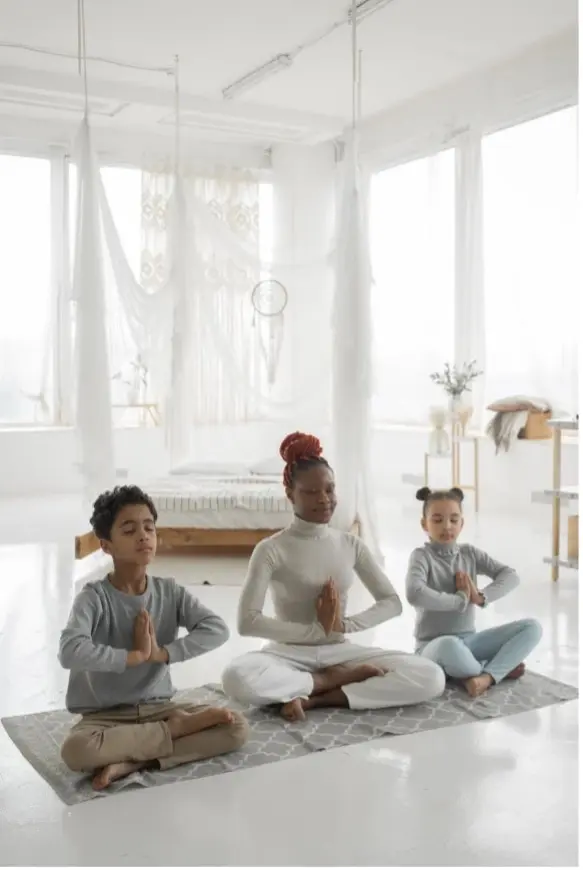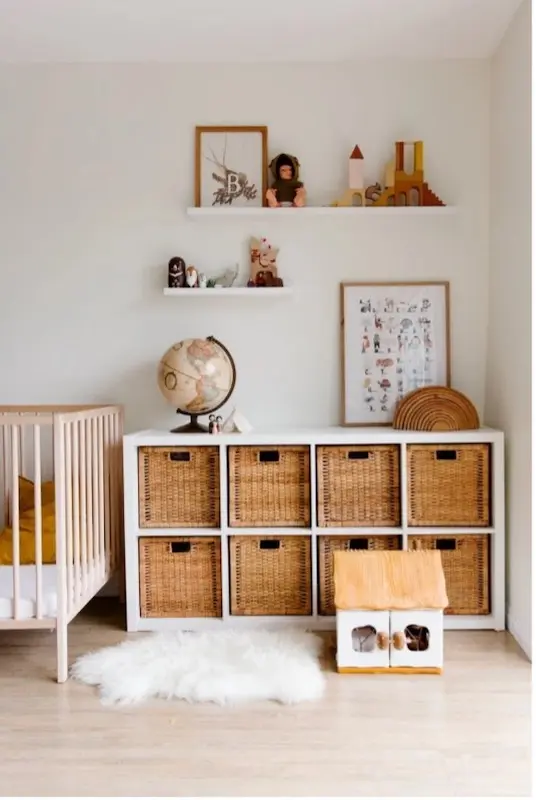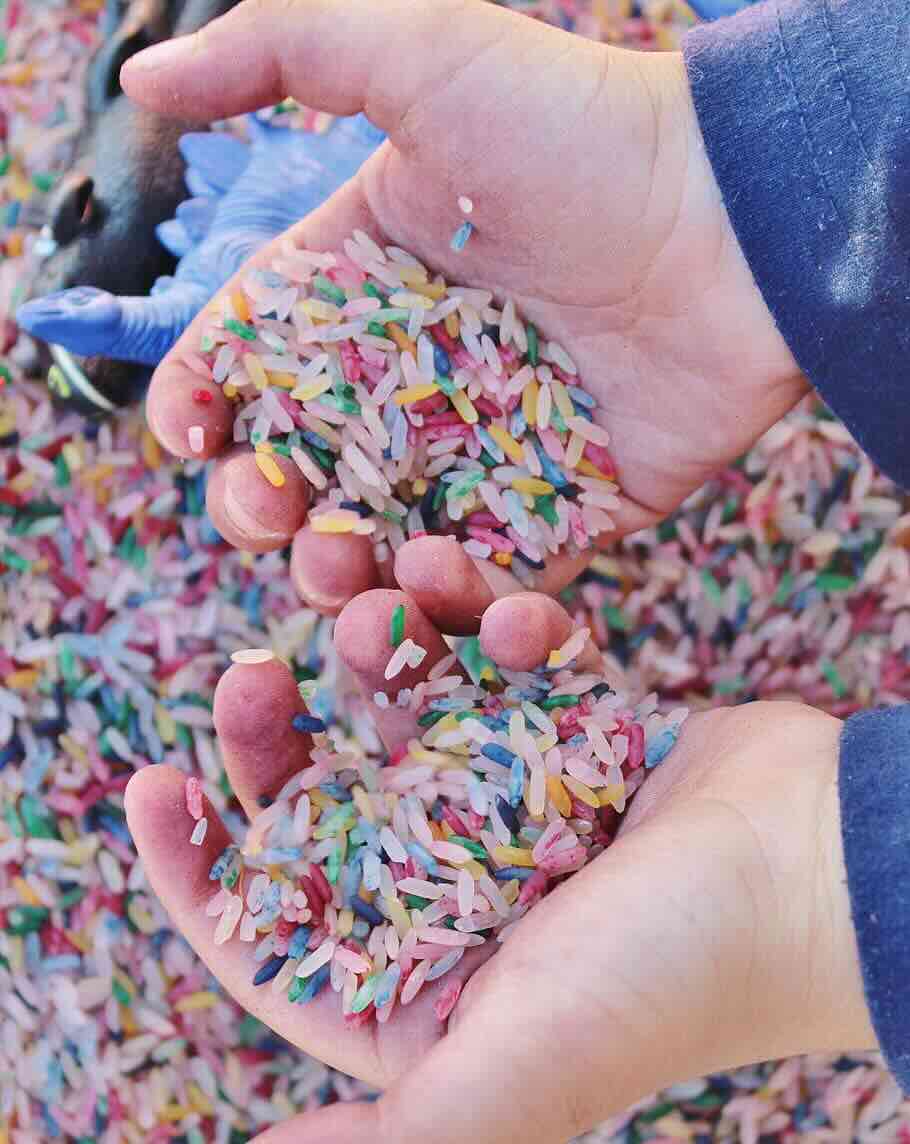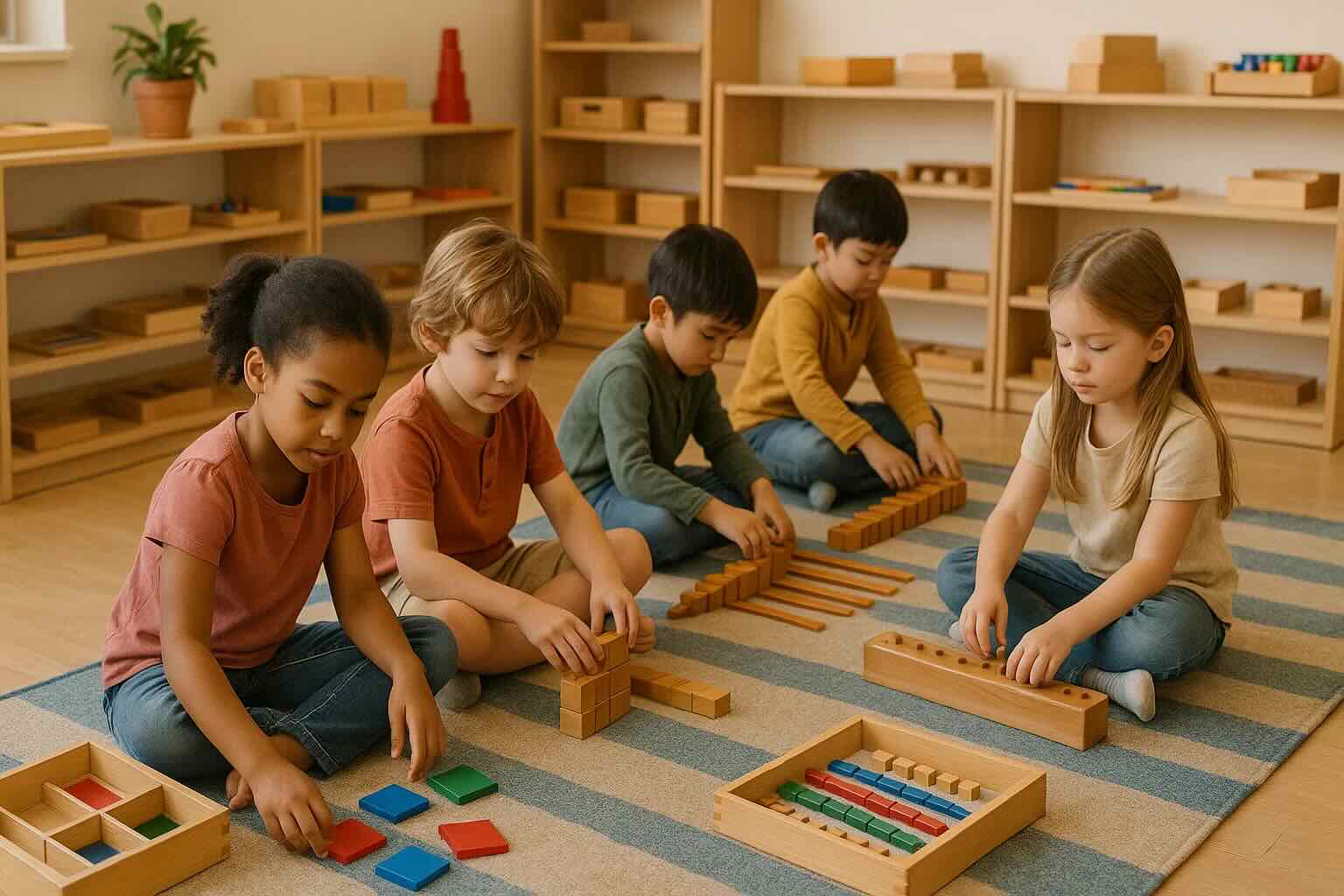Anxiety is a natural part of one’s life. It affects both adults and children. Children go through several transformations as they develop. It’s natural for them to be apprehensive from time to time. Therefore, your kids will most likely go through times in which they exhibit problematic behaviors.
It's tough to control your child’s emotional reactions, especially when under pressure. Relaxing tactics can assist a child in working through intense emotions. Your responsibility as parents is to discover calming activities for anxiety to help children calm down when they become angry or stressed out.
Most of the time, it’s the parental anxiety about certain things that induce stress in kids. These things can be related to toilet training, starting or changing school, or education.

It's beneficial to communicate with your kids about things you were afraid of when you were of similar age. Mainly, talk about similar anxieties you had when you were young. It is definitely beneficial to talk to them and let them know how you overcame those anxieties. You might also explain events that cause stress in other children of their age and calmly ask if this happens with them as well. If this is the case, then you can try out some virtual calming activities with your kids, along with their friends.
For a deeper look at anxiety disorders in children, the American Academy of Pediatrics offers expert guidance.
You can also try being straightforward by asking your child what concerns them the most. Being precise might assist your youngster in sorting through confusing worries and emotions. Encourage them by telling them you believe in them and that having these thoughts is normal. You must also acknowledge your kids’ frightening and nervous feelings as a parent or guardian. At the same time, you should stay calm in front of them, encouraging them to remain peaceful.
The Child Mind Institute offers practical advice on how to respond to anxious children with empathy and confidence.
In a nutshell, anxiety affects people in various ways, and it’s essential to manage it in a timely and adequate manner and acknowledge it before it’s too late. However, if you notice that your child’s anxiety is beyond normal limits, you should consult your physician.
Why Is It Important To Acknowledge Your Kids Anxiety & How Can You Do That?
It’s critical to recognize your child’s emotions and any unusual behaviour that happens because of stress or anxiety. You need to teach them resilience, or the capacity to recover rapidly from stress and anxiety. The first important step is to help them build social connections. Making social connections is an effective way of reducing anxiety and improving mental stability. When children connect with people about common issues, they get a sense of empowerment, which helps them establish deeper relationships around a common cause. And as a parent, you are the first point of contact and hence the most vital connection they can have. Therefore, you should:
- Boost Your Child’s Confidence: Kids usually see themselves through their families’ perspectives and establish their personalities accordingly. Your children notice your way of talking, gestures, and facial expressions. They also note your actions and statements. As a parent, these actions and statements affect their developing self-confidence. So, you should be mindful of how you behave r talk around your kids.
- Catch Their Good Behavior: Have you ever thought of how many times you respond negatively to your children in a single day? You may realize that you are criticizing more than appreciating. This kind of parental behaviour is a cause of autism in kids. Rather than criticizing all the time, try to empathize with them. Discover things that make your kids happy and satisfied. Be effusive with your incentives – your affection, love, and comments work wonders and are frequently enough compensation. Soon, you’ll notice your kid becoming ever more mature and confident.
- Set Limitations: Supervision is crucial for every home. The purpose of discipline is to educate children about proper behavior and self-management. Kids may analyze and test the limitations you set for them. Hence, you need to know the difference between being strict and cautious. Indeed, setting house rules educates your kid about your intentions and helps them build their character.
- Spend Time With Your Kids: It is often tricky, especially for working parents to have a family dinner and spend meaningful time with their kids. But there is perhaps nothing more appealing than having dinner with the family to your children. When kids do not get the care they desire from their parents, they frequently act out or disobey. Wake up 10 minutes earlier on weekends and enjoy brunch with your kids and talk to them about school and other activities. To understand them better, sometimes behave like a kid. You can also try some kids’ activities at home. This will make them realize how important they are to you, and they’ll eventually start putting in the same effort.
The best part is that some practical activities help kids cope with their nervousness. You can also work together with your kid’s teachers to develop calming activities for the classroom. This way, your kid will stay calm at home and in school as well.
Here are ten stress-relieving ways you can include in different activities and perform with your kids:
1. Breathing Methods
When we are nervous, our organs go into a fighting state, leading us to believe that we are in trouble even though we are sitting comfortably. We have all experienced shortness of breath when we become nervous. This is where the breathing exercises become valuable. You can practice these exercises at any time and any place. You can have your kids perform these exercises after playing, or before commencing a lesson. These exercises help kids concentrate better if they are done early in the day. Relaxation and taking deep breathing take only a few minutes. Slow inhalation, dropping pulse rate, and taking deep breaths help provide children with a sense of peace and calmness.
👍 Helpful Hint: Make breathing practice part of your child’s bedtime routine. Doing this consistently each night can condition their mind to wind down and release stress.

Activity 1: Flower and Candle
Tell your child to close their eyes and take long and deep breaths with their noses as if they are smelling a magnificent flower bouquet. Then, tell them to hold it for a few seconds before exhaling it slowly through their mouth as if they are blowing out birthday candles. Do at least 3 sets of 5 with a suitable gap in between every day.
Activity 2: Bubbles
Ask your children to visualize a bubble, stuff it with evil thoughts, and then let it float away. You may even advise your kids to create imaginary bubbles in their minds with positive thoughts so that they remember all the good things in their lives.
You can also give your kids a real bubble-making toy to achieve faster results.
2. Activating Senses
Sensory diversion allows kids to focus away from nervousness and instead focus entirely on the current moment. This is the perfect way to ensure that your kids are paying attention and studying well.

Activity 1: Grounding Approach
Children seek five things they can see, four things to touch, three things to listen to, two things they can feel/sense/smell, and one thing to taste in this activity. This is an excellent grounding practice for kids at any time of day. It banishes fears and anxiety and teaches them to live in the present.
Grounding techniques can be used frequently to use the five senses —sound, touch, smell, taste, and sight. The five senses are all used in order to get rid of distress and anxiety in kids, as it allows kids to live in the moment. Children can utilize their senses by singing, rubbing, smelling fragrances, drinking a cold or hot beverage just to create sensations that distract them from the stressful thoughts in their mind.
💡 Try This: Keep a small “grounding kit” in a pouch with a scented cotton ball, smooth stone, mini fidget toy, and mint candy. Pull it out whenever your child seems overwhelmed.
Activity 2: Observe Sounds
Another fun exercise for kids is to stay quiet for five minutes and concentrate on the surrounding noises. The goal is to listen, take notes, and rest without thinking about or being interested in anything else. Ask kids to observe a clock ticking, traffic sound, the buzz of the screen, or just the sound of tap water. With minimal resources necessary, this is excellent for completing at any time and any place, even in a car. This is an excellent method for sharpening their focus and attention.
Activity 3: Listening to Soothing Music or Voices
While kids are playing, quiet tunes or noises in the background may calm them down. Soft music is a fantastic option and specially refreshing. Stay away from loud music with annoying lyrics.
3. Mindfulness Meditation
Mindfulness meditations enhance concentration and help minimize stress. These practices help exhausted brains relax. They also help improve memory. They also help teach children to handle stress and react to events in a controlled and rational manner. Mindfulness practices are important life skills that kids should learn early on. The following calming activities work best for your kids.

Activity 1: Doodling and painting
Doodling and drawing are excellent mindfulness exercises. They calm the mind and give the children something to engage with. They help reduce the feelings of stress and anxiety in kids.
Activity 2: Play-dough/Clay
Another way to reduce anxiety and fidgeting in kids is through playing with clay or Play-dough. Using oven-baked clay, you can make tiny and smooth relaxation pebbles. Make a thumb-shaped indent in each to help your kid relax while massaging their fingertips on it. You can also gather stones of various shapes, coat them with clay, color them, and carve concise and positive quotations on them.
By stretching, squeezing and pressing into the Play-dough, kids can relieve their tension and stress. Mixing a drop of lavender oil in the dough may also help make this a more calming exercise.
Activity 3: Counting Numbers
Another easy mindfulness practice that makes children concentrate is counting. Counting numbers can be fun and it also helps kids forget about their anxiety and stress. Encourage kids to choose a random number, say 26, and then ask them to count towards it from 0. To make it a bit more challenging, you might even ask them to count backwards and then count by twos, threes, etc.
4. Building Personality
Activity 1: Superhero
Superheroes and their abilities have a significant impact on a child. Allow your child to see themselves as a warrior or a superhero. Ask them about their desired skills and abilities. Then, explore some superhero activities to make them calm or keep them occupied. Be careful, no flying or jumping tall buildings! :)
Activity 2: Boxes of Immediate Happiness or Anxiety Relief
Create a box for your child containing chits with encouraging phrases or comments. You can have them use this as a quick motivational tool when they feel stressed and you are not nearby to console them.
5. Creating Distractions to ignore anxiety
Activity 1: Making Collage
Give your children colorful magazines or vivid photographs. Ask them to make a collage of images they find peaceful. Creating a collage can help them ignore their troubles and let go of their anxiety. It also does not require sophisticated artistic abilities, and your kids can openly express themselves.
Activity 2: Worried brain, happy brain
This practice will benefit you in understanding your child’s capabilities and weaknesses and developing their coping abilities.
Take two sheets of paper and fold them in half. Label one with ‘Happy Brain’ and the other should ‘Worried Brain.’ Let your child write his or her feelings and emotions in each category. Then talk about the feelings under the ‘Worried Brain’ category and how to get rid of them.
6. Being active may help overcome anxiety
Because each child is different, you may expect variety when dealing with these challenges and anxieties. While calm, focused hobbies may benefit some, studies have shown that active kids have higher self-esteem and are less prone to experience stress.

Activity 1: Yoga
Studies have shown Yoga to have several advantages for kids and is one of the most efficient methods for increasing attention in children. Try some yoga positions and add a list of positive mantras. Example mantras can be “I am brave” and “I am loving”; let your children repeat these mantras while performing each posture.
Activity 2: Stretching & Inversion
Stretching and inversion take less than a minute and can be practiced at any time. Begin by urging kids to stand as straight as possible. Have them reach their arms over their heads and balance on tiptoes, then flop back down to a normal standing posture. This is an excellent method to de-stress and feel revitalized.
Inversion is defined as lowering the head below the chest and is thought to have a calming impact on our neurological system. Try leaning over to reach your toes once you and your child have stretched over.
After completing these exercises, you’ll notice how relaxed you and your kid feel.
Activity 3: Skipping Rope
Set your timer for 2 minutes, turn on some music, and have your child hop to the rhythm of the music. If your kid cannot skip rope, hopscotch is an excellent substitute. Try joining your children and do some skipping yourself. It will bring a smile to their face and will make you feel better too!
Activity 4: Walking & Talking Approach
Continuing with the movement theme, try the walking exercise for one-on-one interaction. It will tell you a lot about your kid. This walk will accomplish three things:
It takes them out of the situation.
It offers them the chance to clarify the problem.
It starts their blood circulation, clears out the anxiety-producing impulses, and pours in the pleasant endorphins produced from movement.
Looking for more playful movement ideas? Try these Montessori-inspired dance games to get your child moving and smiling.
🏃 Movement Tip: Combine walks with games like “I Spy” or scavenger hunts. This encourages connection and conversation while subtly reducing stress through physical activity.
7. Writing Thoughts
Studies have shown that writing your thoughts helps you overcome anxiety and stress. When you pen down your thoughts, you shift any negative feelings you may have from your brain to that piece of paper. Therefore, writing about the things that happened throughout the day will help your kid a lot.
Activity 1: Journaling
Give your child a notebook and ask her to write about whatever she likes. It will support them in expressing their thoughts and anxieties and controlling/managing those stress factors.
If they are too young to write, ask them to talk about their thoughts and feelings and write those in a journal. Afterwards, read those back to them. This last step is important because it not only validates what they feel but also lets them know that you, as a parent, listen and care about their feelings.
8. Developing a Relaxation Zone
A quiet corner (relaxation zone) is an excellent idea if your child wants 5 minutes to calm down or needs some alone time. This private zone is great for easing anxiety. Hey, it also means you don’t have to stay around your kid 24/7.
Consider adding the Calming Circles Sensory Rug to your child’s space—its soft textures and colors promote emotional regulation and sensory exploration.

To create a quiet corner for your child:
Pick an excellent semi-private location that is simple to discover and has ample seating.
Include a desk and chair and something comfortable, like a cute teddy and some comfy pillows. Fairy lights can also be an attractive addition.
Decorate the space with their favorite objects.
The quiet corner should consist of everything your kid loves. You might also display a list of things your child can perform in that corner. Including a range of books might give them another avenue to escape.
🌿 Parent Tip: Let your child name their calm corner something fun like “My Chill Cave” or “Cozy Nook.” Giving it a special name helps them associate it with comfort and ownership.
Activity 1: Reading Books
Knowledge is power, as said by many. Kids grasp concepts quickly and start implementing them in their lives. Reading books can help your child develop intellectually. It will also help them in their academic life. You can read them a story when they have problems sleeping because of anxiety. Buy them some excellent books and have them read those whenever they feel anxious or stressed.
A great choice is the My Very Own Name Personalized Book—it fosters self-esteem while providing calming, story-driven engagement.
Activity 2: Bibliotherapy
Bibliotherapy, also known as book treatment or therapeutic reading, is reading a narrative or part of a text to cure or calm children. Read a story to your child and help them connect with similar personalities to theirs. This is great for any age. As a bonus, it will also enhance the listening power of your child.
9. Assembling an Anxiety Toolbox
An anxiety toolbox is an excellent method to educate children in managing their moods independently.

Activity 1: Calming Jar
Calm down Jars are safe and effective tools for children to comfort themselves, calm down, breathe deeply, and deal with their worries. It works as a meditation that a kid may use when stressed, upset, or disturbed. Take a jar, fill it with any transparent liquid and some glitter and spin the jar. Then ask your child to visualize her brain full of swirling thoughts as she spins the jar and sees them gently settle down. She’ll imagine her world brightening up when she watches the glitters go down the jar. This is a wonderful activity for angry kids as it helps them concentrate and correct their behaviors without penalizing them.
Activity 2: Wooden Blocks
You can also buy your child some wooden blocks. Kids can spend hours playing with wooden blocks. Wooden blocks provide your children with the beneficial learning opportunities. Blocks help them develop their cognitive abilities, such as problem-solving, mathematical skills, literacy, and language.
Explore our wooden blocks collection—designed to support focused play and early problem-solving.
Activity 3: Stress Relieving Ball
Stress balls have long been used to ease stress. Pressing a stress ball activates the muscles and nerves, improving the nervous system and lowering cortisol, the primary stress hormone. You can either make a stress ball at home or buy one at the store.
All you’ll need to make one at home is some giant balloons, a tube, and some flour. Load the balloons with flour, insert a tube and bind them tightly. You may also write your child’s name or sketch some emotions on the balloon using a permanent marker (smiley face, happy face, etc.).
Activity 4: Straw and Cotton
Make a two-foot-long tape line on a hard surface - carpet will not work. Put a cotton swab at one end of the line and blow on it with a drinking straw to see whether it will traverse the length of the line. Controlling one’s breath and keeping the cotton on the tape might be difficult, but it’s an entertaining and goofy practice. This diverts the child’s attention away from worrying thoughts and helps them manage their breathing. If kids grow proficient at it, you may make a tape maze instead of a basic line on the floor. Have a good time with this one!
After making this anxiety toolkit for your kid, you won’t be questioning how to calm down a child with anxiety anymore. Your questions will most likely be how to stop a child from giggling and laughing.
10. Expressing The Emotional Side
Everyone has an emotional side, especially kids. If your kid isn’t comfortable showing his emotional side to you, bring them a cute toy or a pet. This will educate them about making friends and expressing their feelings.
Activity 1: Anxiety Companion
Giveyour children a stuffed animal or a pet to help them overcome their fears and anxiety. When your kid is nervous, and anxiety buddy should be there so they can converse and express their emotions in front of it. Also, motivate them to express their feelings about what is troubling them, why it hurts them, and how they want to be. Your kid's mind will be put at ease by the kind and sympathetic company. Try out some calming activities for toddlers with your kid to make it more interesting
If you’re unsure whether your child’s anxiety is typical or needs professional support, the CDC provides guidance on mental health in children.
Childrenare natural monitors with curious minds, not just for studying but also for being compassionate to others around them. Children will sense if their parents are nervous and concerned, which may cause them to be stressed and anxious at home and in school.
So,always keep the following calming activities for preschoolers in mind to assist them in learning and controlling their anxiety.
Activity | Overview | Sets | Time & Place | Benefits |
|---|---|---|---|---|
BREATHING METHODS | ||||
Flower and Candles | - Ask your child to close eyes and take deep breaths with nose - Hold for few seconds - Imagine the smell of flowers and feel it - Exhale slowly and in a controlled manner through mouth as if they are blowing birthday candles | Your child can do this activity twice or thrice a week in 3 sets of 5 with a suitable gap in between. | - There’s no specific time to do this exercise. - Try to keep the surroundings calm and quiet. | -It will help your kids to concentrate and focus.
|
Bubbles | - Ask your child to create imaginary bubbles in their mind. - Fill them with negative thoughts - Blow them away | Do at least twice a month | - You can do this exercise at any time of the day or at any place. - Prefer to perform this activity outdoors such as your garden or parks to encourage positive thinking. | - You can use a real bubble-making toy to achieve fast results. |
ACTIVATING SENSES | ||||
Grounding Approach | - Tell your child to seek for five things to see, four to touch, three to listen, two to smell, and one to taste - Then encourage them to feel all of their senses deeply - You can motivate your children to utilize these senses by singing, rubbing, smelling fragrances, drinking a cold or hot beverage just to create sensations
| Do it regularly and consistently | Gather all things related to the five senses in one place to perform this activity. | - It teaches them to live in present. - It banishes fears and anxiety.
|
Observe Sounds | - Ask your child to stay quiet for five minutes - Observe their surrounding sounds and noises - Listen, take notes and rest. | Do this activity daily for 5-10 minutes | Can be done at any time and from any location. | Don’t try this exercise at a very quiet place. Helps kids practicing to stay focused. |
Listening to Soothing’s Music or Voices | - Play calm music in the background while your kids are playing | Do this activity daily for at least an hour | Try this activity wherever your kids like to play | Avoid using loud, annoying and fast music as the purpose of this activity is to provide relaxation. |
Mindfulness Meditation | ||||
Doodling & Painting | - Get a notebook or any drawing book - Let your child make anything that is going through their minds | Do this activity thrice a week for at least half an hour | If you have a specific drawing-room, try this exercise there. Else, you can do it anywhere in your home or garden area. | This activity is suitable from the age of 3 years. Activity must be supervised by an adult at all times |
Playdough/Clay | - Arrange playdough/clay for your child - Let them make small shapes with clay - Use fingertips to stretch, press and massage it - Clay can also be colored and engraved | Do this at least once a week | You can do this exercise at any time of the day | Your kid can learn various shapes and quotes through this activity. Keep an eye on them. They might try to swallow the clay. You can also add some drops of lavender oil in the dough to make it more calming for kids. |
Counting Numbers | - Let your child choose a random figure - Guide them to start counting to it - Then count back from the chosen number | Do this activity daily for half an hour at least | Kids can try this activity in their study room/long journeys | This will improve your kid's counting ability and distract them from other stressful things. |
Building Personality | ||||
Superhero | - Encourage kids to see them as a superhero of their choice - Ask them to act and pose like their chosen superhero | Do this activity regularly | You can do this activity at any safe place | Kids will acquire new skills and abilities while being occupied. |
Boxes of immediate happiness or anxiety relief | - Ask your kids to create a box - Include some motivating comments and quotes in it - Encourage your kids to open the box and read the chits in your absence | Your child can do this activity whenever you are away | Preferably at home | The created box can be used as a quick motivational tool. |
Creating Distractions To Ignore Anxiety | ||||
Making Collage | - Buy some magazines or photographs - Ask your child to pick some peaceful pictures - Let them make a collage | Do this activity few times a month | You can do this activity anywhere you like | No sophisticated artistic abilities are needed and your kid can openly try out different ideas. |
Worried brain, happy brain | - Take two sheets of paper and fold them in half - Label one as ‘Happy Brain’ and the other as ‘Worried Brain’ - Let your kid add any feelings or emotions under each category | Do at least twice in a month | Can be performed at any suitable place | This will make your child aware and understand their own feelings. This will also help you understand what’s going on in your child’s mind. |
Being actively involved in overcoming anxiety | ||||
Yoga | - Explore some kid’s yoga postures on YouTube - Get your child to copy you while you are doing them - Let them repeat some positive phrases after you | Do this activity daily for half an hour | Can be performed on a matt in your room or garden | This will improve your kid’s overall wellbeing, self-esteem and bond with you. |
Stretching & Inversion | - Get your kids to stretch different parts of their body while copying you - Let them stand as straight as possible by reaching their arms over their heads while balancing on their tip-toes - Then flopping back down to a normal standing posture - Now get them to Lower head below chest and lean over to reach their toes | Do this activity daily for half an hour, preferably as a first thing in morning | Can be performed on a matt in your room or garden | This activity will have a calming effect on neurological system |
Skipping rope | - Turn on music - Take a skipping rope - Hop on to the beats of music | Do this exercise for at least 5 minutes daily in the morning | The best place to do this exercise is a garden or park area if you have access to loud music, otherwise inside house | Hopscotch can be used as a substitute of rope for very young kids Use fast music to energize your kids |
Walking & Talking | - Arrange a walk with your kid and encourage them to talk - Let them share their thoughts and daily activities with you | Do this exercise daily for 15 minutes preferably towards the end of the day | This activity can be performed at any suitable place | This exercise will let you know about your kids' thoughts and what they want to share with you. |
Writing Thoughts | ||||
Journaling | - Encourage your child to keep a journal or a notepad - Let them write their thoughts and activities throughout the day | Do this activity daily | Before going to bed | This will help your kid to express their feelings by writing which they can’t convey to you verbally |
Developing a Relaxation Zone | ||||
Reading books | - Buy some books of your child’s interest - Ask them to read it and then give you an overview of the read | Do this daily | Do this activity at a quiet place | Kids will build their knowledge and vocabulary It will also help improve their memory |
Bibliotherapy | - Get specific text for your child, designed for the purpose of healing - Read a narrative or a story to your kid similar to the current state in which they are in. - This will help your child to deal with the issue objectively which can then be applied to their own problems/issues | Do this daily before sleeping | Do this activity in your kid’s room when they’re off to bed | Besides healing, this activity will also enhance your child’s listening skills |
Assembling an Anxiety Tool | ||||
Calming Jar | - Take a jar - Get your child to fill it up with some glitters or sparkles - Let them spin the jar - Ask them to observe the gentle settling of the content - This will help your kid to imagine the brighter side of their world | This activity can be done as many times as kids like | Can be performed at any suitable place | This activity is good for anger management, improving concentration and correcting your kid’s behaviors without penalizing them |
Wooden Blocks | - Sit down your kid with wooden blocks - Encourage your kid to stack them in different arrangements | Do this activity regularly and consistently | You can do it at any safe place where there is plenty of space to sit and accommodate blocks | It will develop your kid's mathematical, literacy and language, and problem-solving skills. |
Stress-relieving balls | - Get some giant balloons, a tube and some flour - Load the balloons with flour - Insert the tube partially and bind them tightly - Let your child write their name on it or do sketching - Your child can also pump those filled balloons | Do this activity daily whenever you feel to | You can do it anywhere you like | It'll activate your kid's muscles and nerves, lowering the stress hormone. This activity can also be used to manage your child’s anger. You can also buy readymade stress balls for this activity.
|
Straw & Cotton | - Make a two-foot-long tape line on a rough surface - Put a cotton swab at one end - Blow it with a straw - See whether it transverse the length of the line or not - You can assist your child in controlling their breath to keep the cotton on the tape | Do this activity at least once a week | You can do it any safe place where there is a plenty of maneuvering space available | This activity helps kids manage their breathing and diverts them from stressful thoughts. |
Expressing Emotional Side | ||||
Anxiety companion | - Encourage your child to get attached with a stuffed toy or pet - Motivate your child to express their feelings | Do this activity daily and consistently | There are no limitations of location for this activity | This activity puts your child’s mind at ease. Your child will feel as if they have a sympathetic listening buddy with them at all times |








